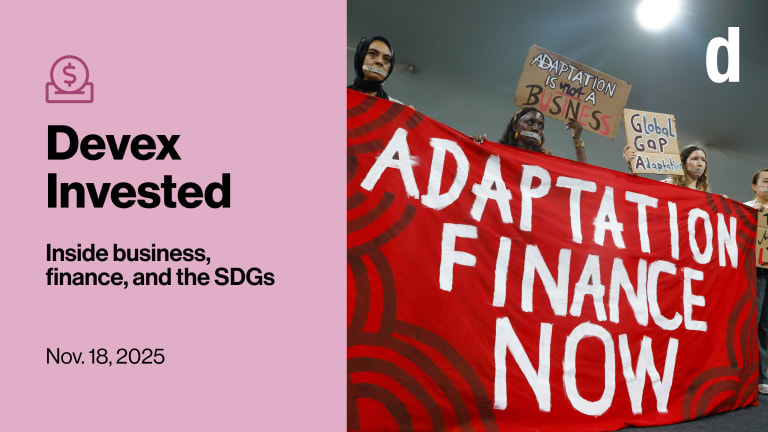
It’s been a busy month for CDC Group, the U.K. development finance institution that’s soon to be known as British International Investment.
This is a preview of Devex Invested
Sign up to this weekly newsletter inside business, finance, and the SDGs, in your inbox every Tuesday.
Apart from the name change, the institution has unveiled a new five-year strategy that will broaden its geographic focus through a pivot to Asia; increase its emphasis on climate finance; and urge more partnership with U.K. companies.
But will it retain its core development mandate? CDC’s chief executive says yes, though development advocates aren’t so sure.
• The new strategy centers on three objectives for investments: supporting development that is productive, sustainable, and inclusive. To achieve those goals, the institution will focus on digital transformation, “gender lens” investing, and climate finance. It plans to be a major infrastructure investor and focus on “SMART sectors”: services, manufacturing, agriculture, real estate, and technology.
• CDC Group plans to expand in Asia, where the institution will focus on climate finance. It will also scale up staffing — perhaps quadrupling it — on the African continent, where it intends to invest about £2.5 billion ($3.3 billion) more in the next five years compared to the past five years. The institution aims for 25% of its investments to meet gender lens investing criteria outlined by the 2X Challenge, and it plans to triple its more risk-tolerant Catalyst Strategies portfolio.
• But a key concern is that expanding investment in the institution means trade-offs — especially during a time of strained aid budgets — and a shift away from the lowest-income countries and people. A group of 12 NGOs has published an open letter criticizing the policy, saying the broadened mandate and renaming appear to be repurposing the institution to focus “solely on private sector investment and profit making, rather than development goals and poverty reduction.”
• “I don’t think we should confuse the tilt towards a much stronger climate agenda with a tilt away from the key mission of CDC, which has always been, and will continue to be, development impact, poverty alleviation in the hardest countries in the world,” CDC’s Chief Executive Nick O’Donohoe said last week during a launch event for the new strategy.
Read: CDC Group launches new 5-year strategy amid NGOs claiming that the reforms dilute U.K. aid's poverty reduction mandate.
+ Devex Pro subscribers can read our interview with CDC Group's chief about the organization's future direction. Not yet a Pro subscriber? Don’t miss out on our special holiday discount and get 25% off your annual Pro subscription.
Are you an ‘SDGenius’?
Have you been paying close attention to the latest in development news this year? We’ve developed a survey to test your knowledge, so for a little fun — and to find out if you’re an “SDGenius” — take the quiz and then share with your friends and colleagues on Twitter, Facebook, and LinkedIn.
Missing the mark
The 20th replenishment round for IDA — the World Bank’s fund for the lowest-income nations — was a mixed bag, my colleague Shabtai Gold reports. The bank secured a record haul and aims to disburse $93 billion during IDA20’s three-year cycle, mixing donor funds with its own resources, as well as money to be raised on capital markets. However, the figure was shy of the $95 billion the bank expected and fell short of the $100 billion sought by African leaders.
IDA20 is aiming to help 74 of the world’s lowest-income nations recover from the COVID-19 pandemic and build back with greater resilience and preparedness for future shocks. This will include support for the health sector, as well as climate finance. The IDA funds will be increasingly targeted toward Africa, and more resources will be allocated to fragile areas and conflict zones on the continent, such as the Sahel.
ICYMI: How IDA20 is an opportunity for health system strengthening
Reality check
A donor pledge to provide $100 billion in annual climate finance to the world’s low-income countries isn’t exactly translating to reality, but my colleague David Ainsworth explores what’s needed to change that. The level of useful climate finance being promised is lower than headline figures might suggest, experts say. And not only that, but this finance is of poor quality, takes too long to access, too expensive, and not reaching the people who need the most help, they tell him.
“With no definition, climate finance providers can count what they want as climate finance,” says Clare Shakya, director of the climate change group at the International Institute for Environment and Development. “We need meaningful transparency. The accountability element is critical.”
Read more: What needs to change to hit the $100B climate finance target?
What we’re reading
In an op-ed, Oxfam staffers explore the role of the financial industry in climate action. [Devex]
Global debt hit record levels last year. But low-income countries are facing financing challenges amid a growing debt divide, according to IMF. [Devex]
Investors face pressure to stop investing in Chinese companies due to growing human rights issues. [Barrons]
The pandemic has led to a rapid rise in U.S. giving to NGOs. [Devex]









